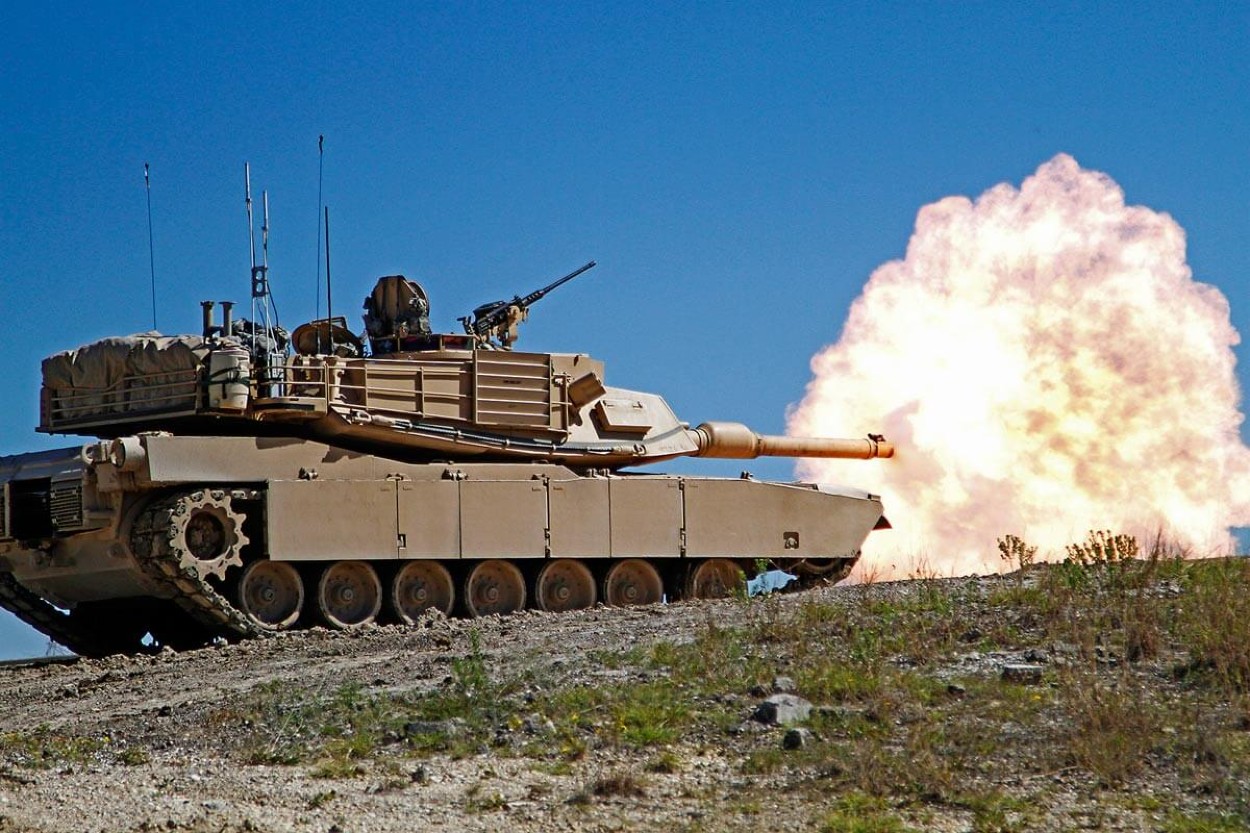The 31 American M1A1SA Abram tanks, which arrived in Ukraine some three months ago and without some key features to satisfy export restrictions, are getting an added layer of protection.
The Ukrainian tankers are adding first-generation ARAT (Abrams Reactive Armour Tiles) airborne explosive reactive armor ahead of the American tank’s debut during the spring offensive.
The tanks have been old and are 2000s vintage. The move was expected as the Ukrainians had added armor to every other tank in their fleet. The only exceptions have been the German Main Battle Tank Leopard 2A6s and Swedish Strv 122s, which are some of the best-protected tanks in the world.
The choice of added protection was between cope cages to protect against drones, slats to defend against rockets, and Explosive Reactive Armour to protect high-explosive rounds. The Ukrainian Army decided to go with the ERA system, which is extremely efficient against shaped-charged jets, and the total weight of the ERA would not compromise the maneuverability of the tank.
The tiles are specifically designed for the Abram tanks. After seeing action in the Iraq War in 2004, the Abrams Reactive Armor Tiles (ARAT) system was created especially for the M1A1 and M1A2 Abrams tanks.
It is based on the explosive reactive armor system known as BRAT (Bradley Reactive Armor Tiles), which was originally developed for Bradley infantry fighting vehicles. Modules with the designation M19 are part of the first generation of ARAT-1.
Explosive Reactive Armour works to lessen the damage to the vehicle it protects. A high explosive sheet or slab is positioned between two plates, usually made of metal and referred to as the reactive or dynamic elements, to form an explosive reactive armor element.
On attack by a penetrating weapon, the explosive detonates, forcibly forcing the metal plates apart to damage the penetrator. It works best as a defense against shaped charges and kinetic energy penetrators that have been specifically toughened.
The ARAT adds extra layers of protection to the tank and the crew members. They are placed on both sides of the hull and turret. The reactive tiles prevent penetration of various weapon systems, such as RPGs (rocket-propelled grenades).
The M-19’s primary flaw, as the Ukrainians have discovered when using it on their M-1s, is that it primarily provides side protection for tanks. It doesn’t mean that the M-1 doesn’t require more armor on its sides; in fact, the frontal armor measures 1,000 millimeters, while the baseline armor is only 250 millimeters thick.
This leaves the M-1’s top, where the steel is as thin as 25 millimeters, as the chink in the armor. The issue arises because the turret on top of an M-1 is filled with intricate electronics, such as antennae and separate sights for the commander and gunner. When ERA explodes, it can harm nearby machinery and possibly even dent the thin steel of the turret.
And without the cope cage, the tanks will be highly vulnerable to drones. And if the 23-month-long Ukraine war is anything to go by, drones have scored the highest number of tank kills.
More Abrams For The Spring Offensive
The Ukrainians had demanded about a hundred Abrams, but only 31 arrived. The nearly two-year-long war has underscored the vulnerability of the armored platforms to precision munition and cheap drones.
At the start of the war, Moscow deployed a much larger number of tanks than Ukraine. Despite attrition, it has managed to keep a substantial force of tanks by bringing the Soviet-era tanks.
In comparison, along with its obsolete T-72s from Eastern European countries, Ukraine has 14 Challenger 2s from the UK, around 100 Leopard 2s from Germany, Denmark, and the Netherlands, and 31 M1 Abrams from the US. After a disappointing fall offensive, if Ukraine wants to have a breakthrough in Russian defenses in the spring, it needs an armored punch.
The Abram have proved their mettle in the battle and are known for their quick mobility. They scan the battleground for targets, attack, and evade the enemy with equal finesse.
It could take out multiple targets from a distance and was agile in a wide array of terrain. Unlike the Soviet-vintage T-72 tanks, whose turret ammunition storage made it vulnerable, Abram separates its crew from the ammunition by blast doors. If the ammunition storage is shot or destroyed, its blast will likely funnel up and out, away from the crew.
Ukraine wants more of the tanks. But unless more tanks arrive, it will do better to armor up the existing ones it has. Without decisive air power, the only way to punch through entrenched defenses is by massing heavy armor.

Where Can The US Find More Tanks?
There has been clamor in the defense experts’ community to supply Ukraine with at least two more brigades of Abrams tanks to overcome Russian defenses. This roughly means 200 more tanks.
The A1 variant, the predecessor of the advanced A2 variant of the Abram tank, is considered a viable candidate. There have been suggestions that the A1s that the Army National Guard is retiring can be sent to Ukraine.
The tanks can be reconfigured to install exportable armor and fire control systems at the Lima tank plant in Ohio and the US Army’s Anniston, Alabama maintenance depot.
“The tanks would still be heavily covered in composite armor and equipped with a 120mm smoothbore gun capable of firing lethal, versatile rounds. With three machine guns and smoke generators that hide the vehicle from visually-sighted or heat-seeking missiles, the modified M1A1s would be a formidable battlefield presence,” the article in Forbes read.
- Ritu Sharma has been a journalist for over a decade, writing on defense, foreign affairs, and nuclear technology.
- She can be reached at ritu.sharma (at) mail.com
- Follow EurAsian Times on Google News




